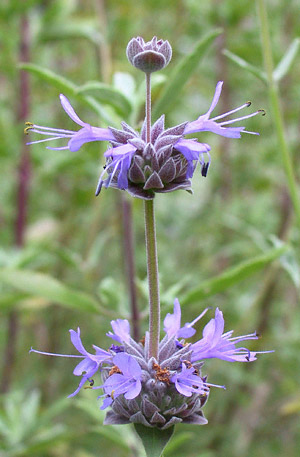
The smell of sage is the smell of the California chaparral. Perhaps the most common and easiest-to-grow native sage is Salvia clevelandii and its numerous hybrids. A shrub roughly 3–5 feet in size, flowering spikes rise up to a foot above the plant during the summer months, holding 1–3 whorls of blue-violet to lilac-blue blooms that open in stages (nicely illustrated in the photo to the right) which are well-loved by hummingbirds and bees. There's nothing to compare to the aroma downwind from a patch; we've placed a chair in the shade right next to our original planting.
Cleveland Sage accepts a range of garden habit. We have some in hard clay that receive no summer water; others on a well-drained slope are watered up to every 10 days. Less water means they will go dormant late in the year; more may shorten their life. In all cases, they prefer full sun. Pruning is best done in two stages: a third off the stems in the fall, and another half of what's left in winter. This will keep a more manageable shape.
Most plants that are commonly called S. clevelandii are actually hybrids, often with another California native, S. leucophylla. The 'true' cleveland selections include Winnifred Gilman and Betsy Clebsch; hybrids which we grow include Carl Nielson, Allen Chickering, Aromas, and Whirly Blue. The first one pictured here is a hybrid; true clevelands tend to have redder stems, darker flowers, and smaller, stiffer habits. S. clevelandii 'Betsy Clebsch' is unusual in that it has blooms that randomly open white as well as blue; unfortunately, our experience has been that it tends to be weaker and harder to grow. Our current “true cleveland” favorite (pictured below) is one we call 'Wild Red' (it originated from a plant grown from seed at The Theodore Payne Foundation).
